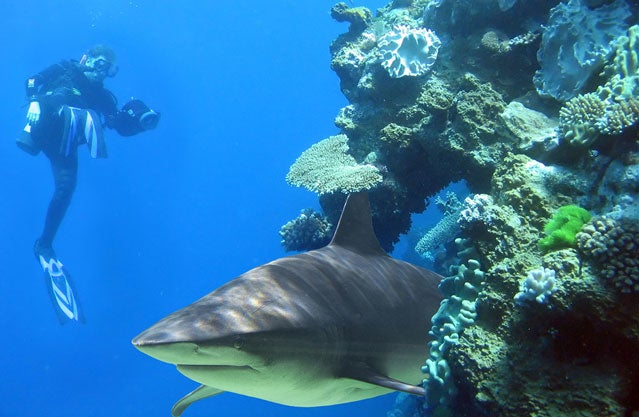In the immortal , the world’s most famous blue tang—Finding Nemo, anyone?—just keep swimming.
“The amount of blood that is produced during menstruation is so small that it becomes background with all of the other components that are in the water,” says Dr. Chris Lowe, head of California State University, Long Beach’s . “It would be very difficult for a shark to localize that.”
Sharks are attracted to the amino acids in your blood. Amino acids, the building blocks of protein, are also present in sweat and urine. But even if you were to perform an amino acid triple whammy of sweating, peeing, and menstruating while you’re swimming in the ocean, the amount of amino acids you’re excreting is relatively minute once those acids are diffused in the water.
All of this means that sharks probably won’t pick up on your period from two miles away and make a beeline for your uterus. And if a shark was already hanging out close by when you entered the water, he’d be relying on other senses, including sight, sound, and electroreception, to track you. At that point, your swimming skills will probably play a bigger role in how appetizing you appear rather than your reproductive cycle.
“From what we’ve seen historically, it’s pretty rare for a swimmer who’s swimming along at a nice clip with a consistent swimming pattern to be bitten by a shark,” Lowe says. “In most cases, humans—especially triathletes—are in good shape, healthy. They’re not giving any signs that would indicate stress or weakness,” which might make you more of a target. The bulk of attacks, Lowe points out, are on surfers sitting in the lineup, waiting for a wave.
Containing your amino acids in a wetsuit won’t make much of a difference, Lowe says. And we all need to be aware that sometimes sharks bite because they feel threatened, for whatever reason, not because you smell or look tasty, or are giving off signals that you’d be easy prey.
“Remember that when you go in the ocean, it’s a dangerous place, it’s not Disneyland,” Lowe says. “You have to understand the risks, but know that your risks of having a negative interaction with a shark are already really low.”
THE BOTTOM LINE: Keep swimming at a nice consistent pace. But if you’re still worried, move your swim workouts to the pool for a week. (Note: The last , near San Diego in 2008, was a 66-year-old man.)


